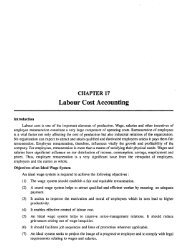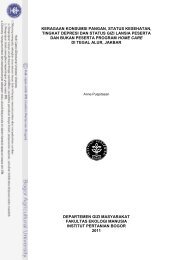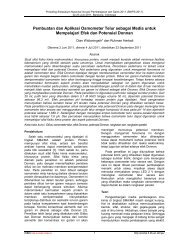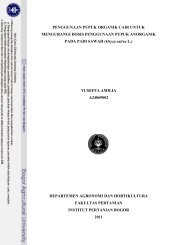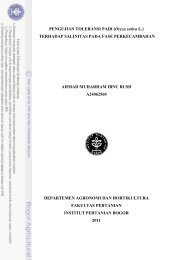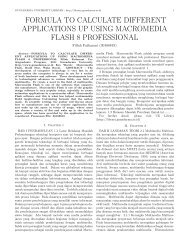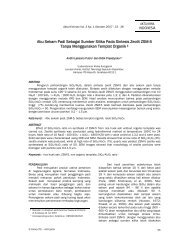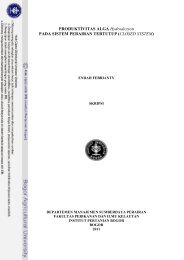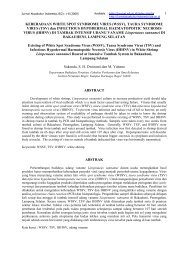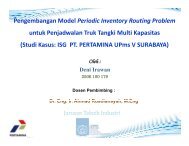Pump and Convective Cum Vacuum Microwave Drying
Pump and Convective Cum Vacuum Microwave Drying
Pump and Convective Cum Vacuum Microwave Drying
Create successful ePaper yourself
Turn your PDF publications into a flip-book with our unique Google optimized e-Paper software.
AJChE 2010, Vol 10, No. 2, 10 – 15<br />
Intermittent Hot Air, Dehumidified Air, Heat<br />
<strong>Pump</strong> <strong>and</strong> <strong>Convective</strong> <strong>Cum</strong> <strong>Vacuum</strong><br />
<strong>Microwave</strong> <strong>Drying</strong> Characteristics <strong>and</strong><br />
Models<br />
Chung Lim Law 1<br />
Chien Hwa Chong 1<br />
Adam Figiel 2<br />
1 Faculty of Chemical <strong>and</strong> Environmental Engineering, The University of Nottingham, Malaysia<br />
Campus, Broga Road, 43500 Semenyih, Selangor Darul Ehsan, Malaysia.<br />
2 Institute of Agricultural Engineering, Wroclaw University of Environmental <strong>and</strong> Life Sciences,<br />
Chelmonskiego 37/41 Street,Wroclaw 51-630, Pol<strong>and</strong>.<br />
*E-mail: Chung-Lim.Law@nottingham.edu.my<br />
An intermittent hot air dehumidified air dryer, a heat pump dryer <strong>and</strong> a convective vacuum microwave<br />
dryer was designed <strong>and</strong> manufactured to dried fruits product. Fresh apple, pear, ciku, papaya <strong>and</strong> mango were<br />
chosen as raw materials. The decreased of moisture ratio with drying time were modeled using semi-empirical<br />
Page equation. This model gave excellent fit for all experimental data with coefficient of determination higher<br />
than 0.9882. In addition, drying characteristics of fruits dried using convective vacuum microwave (C/VM), cyclic<br />
temperature profile (CTP), step-up temperature profile (STP) <strong>and</strong> heat pump (HP) dryers can be obtained from<br />
the analysis of model parameters. <strong>Drying</strong> characteristics versus moisture content curve were used to verify the<br />
parameter asymptotic value. <strong>Drying</strong> characteristics exhibited by various fruit samples in this study were first<br />
falling rate periods, second falling rate periods, increasing rate periods, constant rate periods <strong>and</strong> initial<br />
transient periods depending on the application of processing <strong>and</strong> tempering. The application of convective<br />
cum vacuum microwave (C/VM) in drying of fruits gave the shortest drying time compared to other drying<br />
methods. The effective diffusivity value obtained by C/VM was between 7.08 x 10 -8 to 4.30 x 10 -6 m/min, which<br />
is relatively high compared to fruits dried using other drying methods (2.07x 10 -8 to 5.93 x 10 -8 m2/min). The<br />
results revealed that the drying time for fruits undergone C/VM drying were 50% shorter compared to samples<br />
undergone CTP, STP <strong>and</strong> HP drying. Total drying time needed was between 310 to 490 minutes for drying of<br />
selected fruits using C/VM dryer.<br />
Keywords: Keywords: heat pump, intermittent hot air dehumidified air, convective cum vacuum microwave, drying<br />
characteristics, effective diffusivity<br />
INTRODUCTION<br />
INTRODUCTION<br />
In this study, hybrid or advance drying techniques,<br />
viz. intermittent hot air dehumidified air, heat pump<br />
<strong>and</strong> combined convective vacuum microwave drying<br />
method were used for drying of fruits. <strong>Drying</strong><br />
characteristics of each drying methods in drying of<br />
different fruits were discussed. It is hypothesized that
the application of intermittent drying techniques may<br />
increase the moisture removal from interior to the<br />
surface <strong>and</strong> evaporation by applying inactive drying<br />
condition, which is commonly known as tempering<br />
period. It is useful for rapid internal moisture diffusion<br />
coupled with active drying where drying mediums<br />
such as hot air dehumidified air or superheated steam<br />
is used. This drying methods can produce dried fruits<br />
with better quality product also is part of the<br />
significance of intermittent drying. It has been<br />
reported that intermittent drying could produce<br />
better product quality in drying of guava, banana <strong>and</strong><br />
potato (Chua et al. 2000). Further, the used of C/VM<br />
drying methods also can reduce the processing time<br />
because of large vapor pressure differential between<br />
the middle <strong>and</strong> the surface of the material which<br />
allows rapid removal of internal moisture, whereas<br />
microwaves stimulate vibration of water (resulting in<br />
internal heat generation) by penetrating through the<br />
entire samples.<br />
In this study, two stage drying, advance <strong>and</strong><br />
intermittent drying methods have been used to dry<br />
five selected fruits. In addition, the combined two<br />
stage drying techniques in reducing the processing<br />
time was presented <strong>and</strong> discussed in this study.<br />
Furthermore, drying model parameters with physical<br />
meaning were discussed. These parameters are going<br />
to be used for estimate the effective diffusivity values.<br />
MATERIALS MATERIALS AND AND METHODS<br />
METHODS<br />
Materials<br />
Materials<br />
Fresh samples e.g., apple (Malus domestica), pear<br />
(Pyrus pyrifolia), ciku (Manilkara zapota), papaya<br />
(Carica papaya) <strong>and</strong> mango (Mangifera indica) were<br />
purchased from a local fruit supplier (Semenyih,<br />
Selangor, Malaysia, Latitude 20 57’ °N <strong>and</strong> Longitude<br />
1010 50’6°E. The apple, pear, papaya <strong>and</strong> mango were<br />
cut into dimension of 15 mm cubic using a stainless<br />
steel knife. The ciku was cut into rectangular prism<br />
with Length, width <strong>and</strong> height of 0.05, 0.01 <strong>and</strong> 0.015<br />
(m), respectively.<br />
Chung Lim Law, Chien Hwa Chong <strong>and</strong> Adam Figel 11<br />
Methods<br />
Methods<br />
Intermittent hot air dehumidified air dryer (CTP<br />
<strong>and</strong> STP), a heat pump dryer (HP) <strong>and</strong> a convective<br />
vacuum microwave drying (C/VM).<br />
<strong>Drying</strong>models <strong>Drying</strong> <strong>Drying</strong>models models<br />
The moisture ratio was determined from the<br />
equation (1):<br />
�� = ���� − �� (1)<br />
�� − �� where M(t) denotes moisture content after drying<br />
time t, Me st<strong>and</strong>s for equilibrium moisture content,<br />
<strong>and</strong> M0 is initial moisture. The equilibrium moisture<br />
content Me was determined at the final stage of<br />
drying as an asymptotic value of the function fit to the<br />
experimental points using Table Curve 2D Windows<br />
v2.03. <strong>Drying</strong> kinetics consisted of one, two or three<br />
periods despite of the method applied for fruit<br />
samples dehydration. <strong>Convective</strong> pre-drying was<br />
divided into two periods. The first one was described<br />
using linear equation (2) <strong>and</strong> the second one by an<br />
exponential equation (3):<br />
�� = � − �. � (2)<br />
�� = �� ��<br />
(3)<br />
�<br />
VM finish drying had also exponential character. VM<br />
finish drying took place in the third period of<br />
combined C/VM drying.<br />
Cyclic temperature profile (CTP) drying was<br />
divided into three periods: exponential – linear –<br />
exponential, while step-up temperature (STP) drying<br />
consisted of two periods: linear – exponential. VHP<br />
drying kinetics was described in one period of drying<br />
using a two – term exponential model (4):<br />
�� = �� ��<br />
� + �� ��<br />
(4)<br />
�<br />
All equations 2, 3 <strong>and</strong> 4 were fit to the<br />
experimental points at the highest value of<br />
determination coefficient, r2 .<br />
The values of effective diffusion, Def for drying of<br />
apple, pear, papaya <strong>and</strong> mango were determined at<br />
the falling rate periods of drying from the equation<br />
(5):
12 Intermittent Hot Air, Dehumidified Air, Heat <strong>Pump</strong> <strong>and</strong> <strong>Convective</strong> <strong>Cum</strong> <strong>Vacuum</strong> <strong>Microwave</strong> <strong>Drying</strong> Characteristics<br />
<strong>and</strong> Models<br />
��� = ��<br />
� ∙ 3�� Where:<br />
(5)<br />
��� = Effective diffusion coefficient (m2 .min -1 )<br />
� = Size of cube sample (m)<br />
� = Parameter of drying kinetics equation<br />
(min)<br />
� �� =<br />
� ∙ � � � 1<br />
� �<br />
2<br />
�<br />
4<br />
+ 1<br />
� �<br />
2<br />
�<br />
+ 1<br />
� �<br />
2<br />
Where:<br />
� �� = Effective diffusion coefficient (m 2 .min -1 )<br />
� = Length of the sample (m)<br />
� = Width of the sample (m)<br />
� = Height of the sample<br />
� = Parameter of drying kinetics equation<br />
(min)<br />
RESULTS RESULTS AND AND DISCUSSION<br />
DISCUSSION<br />
<strong>Drying</strong> <strong>Drying</strong> characteristics characteristics <strong>and</strong> <strong>and</strong> drying drying kinetics<br />
kinetics<br />
Fig. 1 shows the drying characteristics of fruits<br />
dried by using different drying methods viz., C/VM,<br />
STP, CTP <strong>and</strong> HP. It is noticeable that the drying rate<br />
curves have a few critical moisture content points.<br />
These results in the existence of various drying<br />
periods namely initial transient period, increasing rate<br />
period <strong>and</strong> multiple distinctive falling rate periods<br />
throughout the drying process. An obvious inflection<br />
point can be clearly seen from the curve that dried by<br />
the C/VM methods because of two stages drying. An<br />
extremely high increasing rate period can be seen<br />
from the graph at the final stage of VM drying. A great<br />
increment of drying rates during VM drying was<br />
because of rapid removal of water from the internal<br />
structure of fruits by the microwave energy. In<br />
convective method hot air transfers energy to the<br />
surface of fruit cube <strong>and</strong> in the same time absorbs<br />
water from the surface. The gradients of temperature<br />
<strong>and</strong> water diffusion are opposite. This creates nonuniform<br />
distribution of moisture inside the cube. An<br />
external layer composed of well dried cells coats<br />
� �<br />
(6)<br />
internal part with higher moisture content. In VM<br />
method the difference in moisture content between<br />
the external <strong>and</strong> internal parts of fruit cube is lower<br />
since water diffusion <strong>and</strong> temperature gradients are<br />
corresponded. This is because of internal heating<br />
provided by microwaves. In combined method C/VM<br />
convective pre-drying is necessary to remove large<br />
amount of water at satisfied drying rate typical for the<br />
first drying period. The non-uniform distribution of<br />
moisture inside the cube created by convective predrying<br />
enhances the process of VM finish drying.<br />
During VM drying the energy of microwaves is<br />
absorbed by water located in the internal part of predried<br />
cube. This creates a relatively large vapor<br />
pressure in the middle of the material, allowing rapid<br />
transfer of moisture to the surrounding vacuum <strong>and</strong><br />
preventing structural collapse. This process, wellknown<br />
as the puffing phenomenon, creates a porous<br />
texture of the food <strong>and</strong> in this way it reduces its<br />
density (Sham et al., 2001). Additionally the capacity<br />
of vacuum pump can be lower because the excess of<br />
water was removed during convective pre-drying.<br />
For heat pump drying, the drying kinetics of fruits<br />
undergone HP drying gave highest drying rates value<br />
at the initial stage of drying compared to other drying<br />
methods. During HP drying, the samples temperature<br />
<strong>and</strong> chamber relative humidity were as low as 36°C<br />
<strong>and</strong> 18%, respectively. Initial drying rate is relatively<br />
high compared to other drying methods. It is because<br />
of the low relative humidity. During drying of green<br />
sweet pepper, Pal et al. (2008) found that relative<br />
humidity is the prominent factor during initial stage<br />
of drying. This is because of high moisture gradient<br />
between the surface <strong>and</strong> environment. Referring to<br />
the later stage of HP drying curve, the drying rates<br />
were lower compared to others. At the later stage of<br />
HP drying, temperature acts as the main driving force<br />
for moisture diffusion.<br />
At the initial stage of drying, drying rates of fruits<br />
undergone STP drying is very low because of the cold<br />
air supplied to the samples. The cold air temperature<br />
<strong>and</strong> relative humidity were about 10°C <strong>and</strong> 68%,
espectively. When hot air was channeled to the<br />
samples, a significant increased of drying rate can be<br />
Chung Lim Law, Chien Hwa Chong <strong>and</strong> Adam Figel 13<br />
Figure Figure 1. 1. <strong>Drying</strong> rate versus moisture content for apple, pear, ciku, papaya <strong>and</strong> mango undergone convective vacuum<br />
microwave (C/VM), cyclic temperature profile (CTP), step-up temperature profile (STP) <strong>and</strong> heat pump (HP) drying.<br />
Table Table 1. 1. Parameters (a, b, c, d) of drying models <strong>and</strong> effective diffusion coefficients Def (m2 min-1) for fruits dried by different<br />
methods.<br />
<strong>Drying</strong><br />
method<br />
Fruit I II III<br />
C/VM �� = � − � ∙ �<br />
�� = � ∙ � ��<br />
� �� = � ∙ � ��<br />
a B r<br />
�<br />
2<br />
a b r 2<br />
Def x10 8<br />
a b r 2<br />
CTP<br />
x10 3<br />
Def x10 6<br />
Apple 1.007 2.83 0.9994 0.6596 215.0 0.9979 3.522 0.1310 5.315 0.9846 1.431<br />
Pear 1.002 2.54 0.9998 0.6988 250.5 0.9983 3.037 0.1571 9.336 0.9822 0.8148<br />
Ciku 1.000 2.99 0.9994 0.6378 230.3 0.9988 2.967 0.1369 7.440 0.9953 0.9183<br />
Papaya 0.9652 5.30 0.9987 0.6604 107.4 0.9968 7.083 0.0564 1.768 0.984 4.302<br />
Mango 1.003 4.12 0.9977 0.5175 128.9 0.9989 5.901 0.0280 4.8905 0.9909 1.555<br />
� � = � ∙ � ��<br />
�<br />
a b r 2<br />
Defx10 8<br />
� � = � − � ∙ �<br />
a B x10 4<br />
r 2<br />
� � = � ∙ � ��<br />
�<br />
a B r 2<br />
Apple 1.002 201.2 0.9997 3.781 0.5488 4.44 0.9994 0.4910 131.6 0.9954 5.780<br />
Pear 0.9848 198.2 0.9882 3.838 0.5576 7.11 0.9885 0.4720 128.2 0.9983 5.934<br />
Ciku 1.0059 211.2 0.9987 3.235 0.5670 7.10 0.9890 0.4817 186.1 0.9988 3.671<br />
Papaya 0.9902 186.7 0.9920 4.074 0.5285 4.20 0.9885 0.4730 178.9 0.9987 4.252<br />
Mango 1.001 201.5 0.9999 3.755 0.5502 7.30 0.9998 0.4658 178.0 0.9988 4.273<br />
STP � � = � − � ∙ �<br />
a B x<br />
10 4<br />
r 2<br />
�� = � ∙ � ��<br />
�<br />
a b r 2<br />
Def x10 8<br />
Apple 1.9998 7.42 0.9901 0.9259 169.9 0.9980 4.477<br />
Pear 1.001 8.11 0.9996 0.9110 162.9 0.9987 4.670<br />
Ciku 0.9993 9.05 0.9998 0.8845 211.1 0.9760 3.237<br />
Papaya 0.9899 10.4 0.9697 0.8656 250.3 0.9998 3.039<br />
Mango 1.000 7.99 0.9919 0.9175 180.0 0.9986 4.226<br />
HP<br />
�� = � ∙ � ��<br />
� + � ∙ � ��<br />
a<br />
�<br />
b c d r 2<br />
Apple 0.7051 1.961 0.2992 39.58 0.9990 3.879<br />
Pear 0.7628 203.8 0.2377 23.83 0.9996 3.732<br />
Ciku 0.7956 328.9 0.2079 24.05 0.9970 2.077<br />
Papaya 0.806 220.4 0.2201 33.83 0.9997 3.451<br />
Mango 0.8417 201.9 0.1586 18.33 0.9996 3.768<br />
I, II,III – periods of drying<br />
r2 – coefficient of determination<br />
Def x10 8<br />
seen from Fig. 1. Bulk moisture removal effect<br />
occurred because of the application of hot air. During<br />
Def x10 8
14 Intermittent Hot Air, Dehumidified Air, Heat <strong>Pump</strong> <strong>and</strong> <strong>Convective</strong> <strong>Cum</strong> <strong>Vacuum</strong> <strong>Microwave</strong> <strong>Drying</strong> Characteristics<br />
<strong>and</strong> Models<br />
cooling period, fruits cell’s structure will shrink. When<br />
hot air charged to the fruits, the cell structure<br />
will exp<strong>and</strong>. Thus, bulk moisture move from the<br />
internal part to the fruits surface. This increment of<br />
drying rate is because of the drying temperature<br />
difference between the active hot air drying<br />
<strong>and</strong> cold air tempering w as as high as 40°C,<br />
w hich created a greater driving force for diffusion of<br />
internal moisture.<br />
For fruits undergone CTP drying, a minimum point<br />
can be seen from the drying rate versus moisture<br />
content curve. The decreasing of drying rate at this<br />
point is because of the implementation of cold air<br />
drying between two hot air drying periods. Resuming<br />
of hot air drying after the cold air tempering<br />
period also create a puffing condition, where bulk<br />
moisture diffuse to the surface of the samples.<br />
Comparison of overall drying duration<br />
Comparison <strong>Drying</strong> of apple, of overall<br />
pear, drying mango, duration<br />
ciku <strong>and</strong> papaya by<br />
drying the C/VM duration method required shorter drying duration<br />
compared to other drying methods. The total drying<br />
time used for drying of apple, pear, ciku <strong>and</strong> mango<br />
using the C/VM methods was about 490 minutes. For<br />
papaya that dried under the C/VM method, about 310<br />
minute was needed, which is the faster compared to<br />
other drying methods. The drying time is extremely<br />
short because of uniform penetrating energy with the<br />
application of microwave power between 120 –360<br />
W during second stage of drying. In addition, puffing<br />
effects occurred during C/VM drying could be one of<br />
the reasons because of large vapor pressure gradient<br />
between the samples interior <strong>and</strong> surface creates an<br />
internal moisture vibration. According to Kaensup et<br />
al., (2002), during vacuum microwave drying,<br />
moisture at the inner part of the samples would<br />
remove rapidly with increasing vapor pressure.<br />
<strong>Convective</strong> <strong>Convective</strong> <strong>Convective</strong>vacuum vacuum vacuum microwave microwave (C/VM) (C/VM) drying<br />
drying<br />
curves<br />
curves<br />
For parameters obtained from linear eq. (2), the a<br />
is the initial value of moisture ratio during drying. The<br />
b value is a drying rate at the first drying period<br />
calculated by differentiation of eq. (2). It is obvious<br />
that the higher b value the higher decrease in<br />
moisture ratio per minute. For parameters obtained<br />
from exponential eq. (3), parameter a can be treated<br />
as critical point, MRcr that divides the drying process<br />
into constant rate period <strong>and</strong> falling rate period. In<br />
this case the b parameter corresponds to time<br />
constant. In the falling rate period described by eq. (3)<br />
the higher b value the lower decrease in moisture<br />
ratio per minute is observed. The b value during<br />
drying period I <strong>and</strong> II were between 2.54x10 -3 to<br />
5.30x10 -3 <strong>and</strong> 107 to 250, respectively (Table 1). First<br />
falling rate period <strong>and</strong> second falling rate period were<br />
exhibited during drying period II <strong>and</strong> III.<br />
Cyclic Cyclic Cyclic temperature temperature profile profile profile (CTP) (CTP) drying drying drying curves curves<br />
curves<br />
The features of this drying profile are cold air can<br />
be supplied to the samples in the middle of drying<br />
process. Parameter b obtained from the linear model<br />
as shown in Table 1 ranges from 4.2x10 -4 to 7.11x10-4 .<br />
This value indicates that the drying rate was<br />
extremely slow. The purpose of applied cold air in the<br />
drying process is to reduce the surface temperature to<br />
avoid case hardening effect. The pore <strong>and</strong> cell<br />
structure of the samples could be retained<br />
throughout the cold air tempering period. More<br />
moisture could diffuse to the sample surface for<br />
evaporation. As mention in C/VM drying models, a<br />
value is the moisture ratio of the samples. In this case<br />
a value indicates initial moisture ratio for the cold air<br />
period. During cold air tempering period, moisture<br />
reduction rate is very low, which is about 13%<br />
throughout the tempering period.<br />
Step Step- Step<br />
-up up temperature temperature - profile profile (STP) (STP) drying drying drying curve<br />
curve<br />
STP drying consisted of two drying period: linear<br />
(I) <strong>and</strong> exponential (II). Parameters used in this models<br />
are a <strong>and</strong> b. At the initial stage of drying, cold air was<br />
channeled to the fruits. Moisture evaporated from the<br />
samples at this stage was about 10% of the initial<br />
moisture content based on the a values shown in<br />
Table 1. Cold air tempering allows internal moisture
diffuse to the samples surface while maintaining the<br />
surface temperature at low level. When hot air<br />
applied to the samples, bulk moisture at the sample<br />
surface was removed through evaporation.<br />
Heatpump(HP)dryi Heat Heatpump(HP)dryi pump (HP) dryingcurve ngcurve ng ngcurve curve<br />
The drying equation used to model the drying<br />
kinetics of fruits under HP was two term exponential<br />
model. This model consists of four parameters.<br />
Combination of parameter a <strong>and</strong> c represent the<br />
moisture content of fruits <strong>and</strong> b is selected as drying<br />
constant for effective diffusivity determination. The<br />
samples undergone HP drying exhibited an initial<br />
transient period <strong>and</strong> one falling rate period. Referring<br />
to Fig. 1, the initial transient period only happened at<br />
the first 30 minutes of drying when the moisture<br />
content decreased from 8 – 6 g H2O/ g DM, 7 – 4 g<br />
H2O/ g DM, 3.8 – 2.5 g H2O/ g DM, 8.3 – 5.5 g H2O/ g<br />
DM, 5.5 – 3.5 g H2O/ g DM for apple, pear, ciku,<br />
papaya <strong>and</strong> mango, respectively.<br />
CONCLUSIONS<br />
CONCLUSIONS<br />
Overall drying time for production of dried apple,<br />
pear, papaya, mango <strong>and</strong> ciku by using C/VM was<br />
between 306 to 504 min, which is about 50% shorter<br />
than other drying methods tested in this study. The<br />
effective diffusivity value was between 7.08x10 -8 to<br />
1.56 x 10 -6 m 2 /min, which were higher than fruits<br />
undergone CTP, STP <strong>and</strong> HP drying methods<br />
(2.08x10 -8 to 5.78x10 -8 m 2 /min). The models<br />
Chung Lim Law, Chien Hwa Chong <strong>and</strong> Adam Figel 15<br />
asymptotic values represent the moisture content<br />
<strong>and</strong> critical moisture content of the drying profile.<br />
ACKNOWLEDGEMENT<br />
ACKNOWLEDGEMENT<br />
The authors wish to acknowledge the support<br />
given by The Ministry of Science <strong>and</strong> Technology <strong>and</strong><br />
Innovation, Malaysia through e-Science funding (03-<br />
02-12-SF0001) <strong>and</strong> The Polish Ministry of Science <strong>and</strong><br />
High Education Project (N312 031 32/2036).<br />
REFERENCES<br />
REFERENCES<br />
Chua, K.J., Mujumdar, A.S., Chou, S.K., Hawlader,<br />
M.N.A., & Ho, J.C. (2000). <strong>Convective</strong> drying of<br />
banana, guava <strong>and</strong> potato pieces: effects of<br />
cyclical variations of air temperature on convective<br />
drying kinetics <strong>and</strong> colour change. <strong>Drying</strong><br />
Technology, 18, 907-936.<br />
Kaensup, W., Chutima, S., & Wongwises, S. (2002).<br />
Experimental study on drying of chilli in a<br />
combined microwave-vacuum-rotary drum dryer.<br />
<strong>Drying</strong> Technology, 20, 2067–2079.<br />
Pal, U.S., Khan, M.K., & Mohanty, S.N. (2008). Heat<br />
pump drying of green sweet pepper. <strong>Drying</strong><br />
technology, 26, 1584-1590.<br />
Sham, P.W.Y., Scaman C.H., & Durance, T.D. (2001).<br />
Texture of vacuum microwave dehydrated apple<br />
chips as affected by calcium pretreatment,<br />
vacuum level, <strong>and</strong> apple variety. Journal of Food<br />
Science, 66, 1341-1347.



